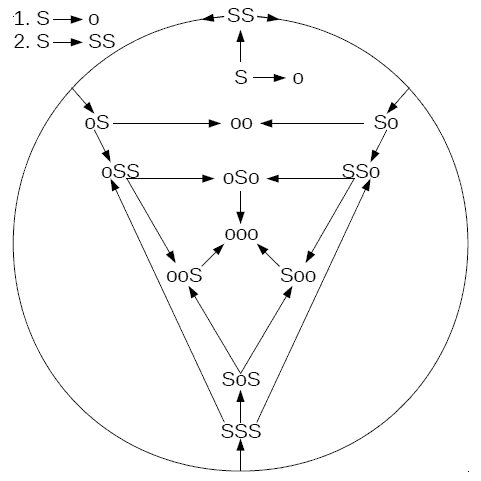
Grammatica formale per le espressioni di operazioni binarie.
Formal grammar. es lingua naturale.
Σ = {a, b, c} the alphabet
S the start symbol
1. S → aSb the production rules
2. S → c
we start with S, and can choose a rule to apply to it.
We can write this series of choices more briefly, using symbols:
S ⇒ aSb ⇒ aaSbb ⇒ aacbb.
The language of the grammar is then the infinite set
{ancbn ∣ n ≥ 0} = {c, acb, aacbb, aaacbbb, …}
n in particular represents the nr of times production rule 1 has been applied.
| 1. S → a 2. S → Sa |
1. S → a 2. S → SS |
producono le stesse stringhe |
| 1. S → a 2. S → Sa |
S 1 a S 2 Sa 1 aa S 2 Sa 2 Saa 1 aaa S 2 Sa 2 Saa 2 Saaa 1 aaaa S 2 Sa 2 Saa 2 Saaa 2 Saaaa 1 aaaaa S 2 Sa 2 Saa 2 Saaa 2 Saaaa 2 Saaaaa 1 aaaaaa |
tutte le produzioni di una stringa lunga fino a 3

| 1. S → a 2. S → SS |
S 1 a S 2 SS 1 Sa 1 aa
2 SSa 1 Saa 1 aaa
1 aSa 1 aaa
1 aS 1 aa
2 aSS 1 aSa
1 aaS 1 aaa
2 SSS 1 SSa
1 SaS 1 Saa 1 SaS 1 aaS 1 aSS |
la stringa lunga 3 si puo' produrre in 10 modi diversi
| L1 | L2 |
|---|---|
| 1. S → a 2. S → Sa |
1. S → ε empty string 2. S → Sa |
The language of the grammar is the infinite set
L1= {an ∣ n > 0} = {a, aa, aaa, …}
L2= {an ∣ n ≥ 0} = {ε, a, aa, aaa, …}
